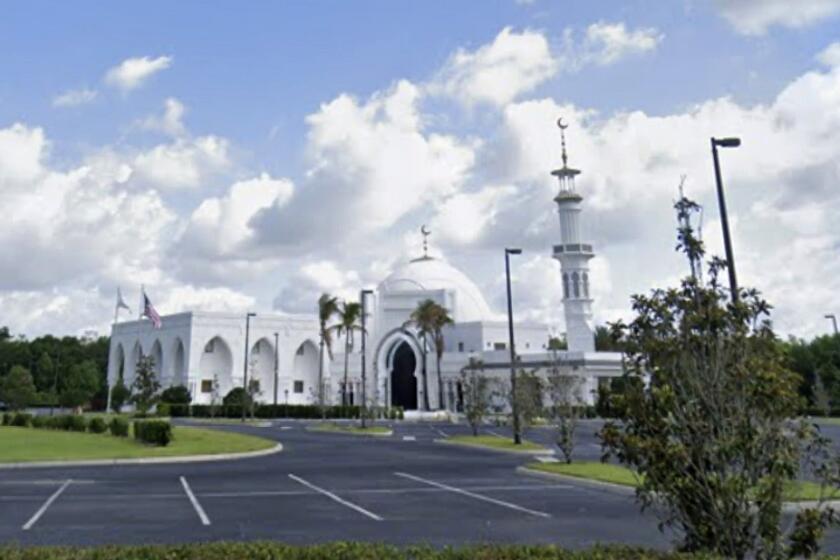East Meets East : New Wave of Asians Is Moving Beyond Monterey Park in the San Gabriel Valley
Norman Hsu remembers his first impressions of Monterey Park when he came to this country from Indonesia in 1979.
Bustling streets, Chinese shops, the sound of Mandarin and Cantonese being spoken on the street. Hsu was struck by its similarity to his hometown of Pancoran, a Chinese enclave in Jakarta.
But he also found relentless traffic, crime and a lack of peace among the races--also reminders of life in Indonesia. He decided to settle about 10 miles east of there in Hacienda Heights instead.
“Monterey Park and (nearby) Alhambra are like starting points for new immigrants,” Hsu said. “But once they’ve settled down, they want to move on.”
Second Migration
After more than a decade of booming growth that transformed Monterey Park into the nation’s first suburban Chinatown, a second migration of the Asian community in the San Gabriel Valley is now taking place.
Thousands of Asians have followed in Hsu’s footsteps in recent years, bypassing or leaving Monterey Park for the pastel-colored housing tracts and tree-lined streets of the eastern portion of the valley.
Fueled by a desire to assimilate into American society or to avoid the congestion, racial tensions or skyrocketing housing prices in communities near Monterey Park, an increasing number of Asians are settling in an area eastward along the Pomona Freeway.
Of the estimated 180,000 Asians in the San Gabriel Valley, a quarter live along this 15-mile corridor, encompassing the cities of Walnut, Hacienda Heights, Rowland Heights and Diamond Bar, according to school enrollment figures, real estate brokers and community leaders.
The migration includes Koreans, Cambodians and Vietnamese, but the largest group appears to be Chinese from Taiwan, Hong Kong or China.
“Monterey Park will always be the center, but living-wise, people are moving further away,” said Fred Hsieh, a Chinese developer who is largely credited with sparking the boom in Monterey Park. “For anyone who can drive, there’s no reason to stay anymore.”
The eastward migration has been followed by a blossoming of Asian businesses, community groups and cultural centers that have made cities such as Hacienda Heights (known as Ha Gang) or Walnut (known as Hu Tao Shi) as familiar to some in Taiwan as they are to Angelenos.
Super Supermarket
Just last month, businessman Roger Chen and investors from Taiwan opened in Rowland Heights one of the largest Asian grocery stores in the nation--an acre of splashing fish, pungent sauces and fresh produce.
Korean acupuncture clinics and Chinese supermarkets dot Colima Boulevard, a major valley thoroughfare.
On a hillside in Hacienda Heights, Fo Kuang Shan, Taiwan’s preeminent Buddhist organization, opened an awe-inspiring monastery last year that is the largest in the Western Hemisphere.
As the movement into the eastern reaches of the valley continues, small but discernible changes have occurred in Monterey Park and nearby Alhambra.
“Basically, we’ve reached the saturation point and we’re growing very slowly,” said Alhambra City Manager Kevin Murphy. “This isn’t the hot place it used to be.”
Boom Is Over
Asians now account for about half of Monterey Park’s 64,600 residents, but school enrollment figures show that their numbers are growing at the slowest rate since the boom began in the mid-1970s.
“Everyone rushed in and now it’s maxed out,” said Anthony Woo, a bilingual specialist for the Garvey School District. “The word boom is over.”
Hsu, like others, said he was determined not to repeat his family’s insular existence in Indonesia.
“Pancoran is like Monterey Park--all the Chinese live together,” he said. “When I came to this country, I didn’t want to live in Monterey Park. I wanted to assimilate.”
So Hsu, 53, a postal worker, moved to a tract home in Hacienda Heights, where as recently as 1980 there were fewer than 200 Chinese families. Today, that community’s local association of Chinese residents has more than 500 families as members.
Buying Larger Homes
In recent years, skyrocketing housing prices in Monterey Park also have made it tempting for some Asian residents to sell their homes and buy larger, more modern homes in the eastern San Gabriel Valley.
Others have been forced to look east because they can no longer afford a house in Monterey Park and its neighboring cities, where the average home price pushed past $230,000 during the last six months, according to listings of home sales.
Last year, Frank Chin, a 34-year-old software engineer who brought his family to the United States from Vietnam, began looking for a house in Alhambra.
He envisioned a fixer-upper but was dismayed that two-bedroom homes were selling for more than $200,000. Chin ended up buying a new four-bedroom house in the Chino Hills area for $160,000.
“For less money we got this house and you don’t have to do anything to it,” he said. “They used to say, ‘Go west, young man.’ Now, it’s, ‘Go east.’ ”
School Enrollment
In Walnut, the migration is illustrated by school enrollment statistics showing that the number of Asian students in the Walnut Valley School District has nearly tripled, from 847 to 2,391, since 1984 and has been increasing by about 30% each year. Asians now make up about a fifth of the 11,553 students in the district.
The concentration of Asian residents in the eastern San Gabriel Valley is still far below that of Alhambra and Monterey Park. And because there has been little commercial development accompanying the eastward migration, the movement has caused far less turmoil than in Monterey Park. But there have been sporadic problems.
On the hillside above Hacienda Heights is the Hsi Lai Temple, a sprawling complex of red pillars and gold trim that looms over nearby tract homes like a vision from imperial China.
Residents complained that the temple had no place in a residential neighborhood, but it was built anyway and it opened its gates last year.
Some neighbors still bear a lingering bitterness over the project and the new Asian residents. “They don’t want to mix, they don’t want to become Americans,” said Sharon Pluth, a community leader. “As an American, I feel a little strange in my own country.”
New Crimes
A more disturbing phenomenon has been the appearance in the last year of new crimes in the eastern San Gabriel Valley that police are still struggling to understand.
Detective Dennis Miller of the sheriff’s station in Industry has saved a file of photocopied crime reports that he began compiling last May, when the first of a series of unusual crimes occurred.
Around 10 p.m. one night, two men armed with pistols burst into a Hacienda Heights home, bound the hands of family members and threatened to kill the youngest child unless the family handed over its valuables.
Both the victims and the robbers, who were never caught, were Vietnamese. There have been at least nine other similar residential robberies since May.
“They’ve never picked a person without money and they’ve never picked a non-Asian,” Miller said.
Some Feel Threatened
For some, like Monterey Park Mayor Barry Hatch, who has become a national media personality because of his table-thumping views on immigration, the changes are threatening.
“The race of the Chinese has over a billion people and they’re looking for a soft place to land,” he said. “There’s nowhere else but here. The whole valley is what they want.”
But for others, there is no grand design in the eastward migration. It is a movement in search of a better life that began in the Far East and has continued in this country.
David Chen came to America a decade ago so his children could receive a good education. He is now a partner in an advertising company on Wilshire Boulevard.
He has four cars in the driveway, two sons in college and, if he looks hard enough from the second floor, above the trees and rooftops, he can just catch a glimpse of a peak in the Puente Hills.
“The American Dream?” he said. “I think I’m not too far away.”
More to Read
Sign up for Essential California
The most important California stories and recommendations in your inbox every morning.
You may occasionally receive promotional content from the Los Angeles Times.











